Can President Trump Trigger a Coal Industry About-Face?
On January 20, 2017 Donald Trump was sworn in as the 45th President of the United States. During his campaign, he assured the citizens of this country he would Make America Great Again, and one of the many ways he promised to reach that goal was through reviving the coal industry. One avenue President Trump has vowed to take is the dismantling of the Obama administration’s coal regulations, including the Clean Power Plan. The Clean Power Plan (CPP) is a rule proposed in 2015 under the Clean Air Act to force power plants to decrease their carbon emissions, helping to address climate change.
Critics of the CPP say it is an assault on the coal industry that will kill jobs while greatly increasing energy costs for the American consumer. Supporters say it’s an historical step in the right direction of fighting pollution and climate change that will have little effect on the already-declining coal industry.
The CPP was stayed by the Supreme Court a year ago, in February 2016, and with Trump’s election and subsequent nominations of Scott Pruitt (a self-proclaimed “leading activist against the EPA’s activist agenda”) to the head of the US Environmental Protection Agency (EPA) and Neil Gorsuch to fill the vacant seat on the Supreme Court, it’s not clear how the plan will go forward. However, the issues the CPP has raised on both sides have shined a spotlight on the state of the American coal industry and what has shaped its steep decline over the last decade.
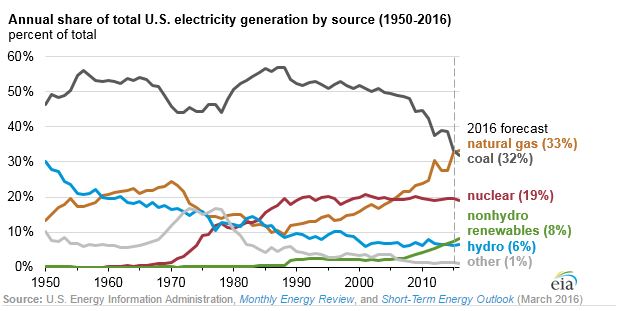
Let’s take a look at two key drivers:
The Clean Air Act (CAA):
To truly understand how coal has gone from providing almost 60% of our nation’s electricity to providing only 32%, we have to take a trip back to when environmental protection regulations first came into play. Through the strict regulation of what the EPA calls “major stationary sources of air pollution,” the CAA has had significant impacts on the coal industry.
Air pollution regulation started its journey toward federal oversight in 1955 with the Air Pollution Control Act, and every step along the way has led to tighter regulations, stricter enforcement, and harsher consequences for coal-fired power plants.
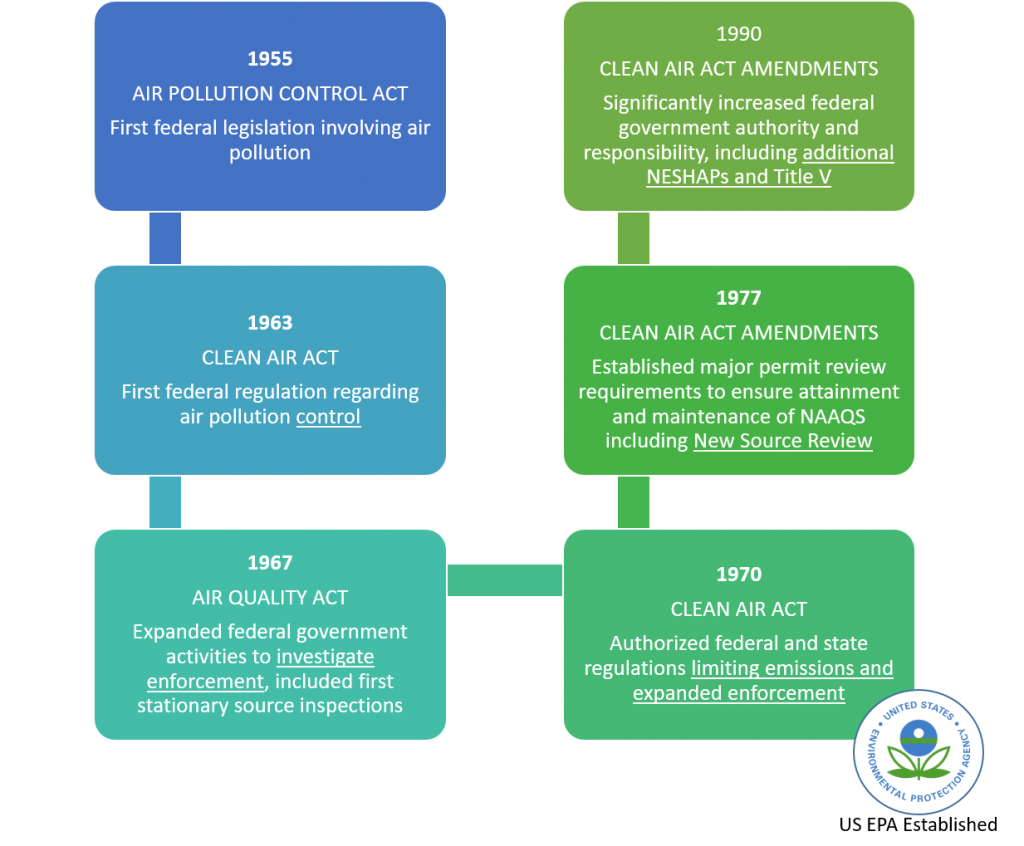
Here’s some history on the CAA:
The first federal legislation to pertain to controlling air pollution was the CAA of 1963. The law authorized research into techniques for monitoring and controlling air pollution. Then, in 1967, the Air Quality Act enabled the federal government to increase its activities to investigate enforcing interstate air pollution transport and perform the first stationary source inspections and far-reaching ambient monitoring studies.
President Nixon signed further amendments into law in 1970, which substantially increased the federal government’s role in the control of air pollution. The legislation:
- Allowed the development of federal and state limits on emissions from stationary and mobile sources (industrial facilities and motor vehicles)
- Established the National Ambient Air Quality Standards (NAAQS)
- Initiated State Implementation Plans (SIPs)
- Authorized New Source Performance Standards (NSPS)
- Instituted National Emission Standards for Hazardous Air Pollutants (NESHAPS)
In December of that same year, the US EPA was established to consolidate the research, monitoring, standard-setting, and enforcement of the requirements included above.
The establishment of the EPA and the 1970 amendments paved the way for the federal government’s 1977 Clean Air Act Amendments (CAAA), which had a major impact on coal end users, such as coal-fired power facilities and industrial boilers. With the 1977 CAAA, the federal government set forth the provisions for Prevention of Significant Deterioration (PSD) and the permitting process known as New Source Review (NSR). NSR requires power plants to submit construction plans to EPA for review prior to making modifications to new facilities or building new facilities if they will create a “significant increase” of a regulated pollutant; however, the rule does not require “routine scheduled maintenance” projects to be reviewed. It is this permitting process that has caused much tension among the EPA, environmental groups, and utilities companies, costing utilities billions. (More on that in a bit.) It also required states to submit plans for nonattainment areas (areas that have not met the NAAQS) to reach attainment status within five years.
Next let’s turn to the 1990 CAAA which, proposed by President George H.W. Bush, addresses acid rain, urban air pollution, and toxic air emissions. The amendment also authorizes a national permitting program (Title V) that requires large businesses to address, control, and minimize air pollutants through planning and reporting processes. Because coal-fired power production generates 71% of the electric power sector’s carbon emissions, these amendments, like the ones before them, have had significant impacts on the industry.
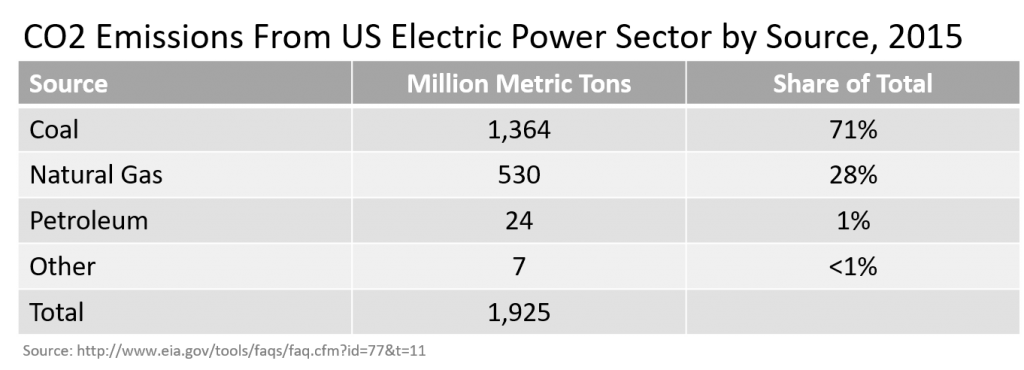
Now, back to the NSR process. Because of a lack of clear definitions of “significant increase” and “routine scheduled maintenance,” NSR permitting became a very gray area for some utility companies. In 1999, the EPA began a concerted effort to enforce NSR compliance and began filing civil complaints against plants they said had illegally released pollutants through violation of the NSR rule. From 2000 to 2015, there were over 30 coal-fired power plant settlements resulting in closure of plants and generating company commitments to spend millions on environmental mitigation projects, billions on environmental cleanup at their facilities, and civil penalties of $96 million dollars.
The cost of the settlements alone is enough to create significant financial consequences for utilities companies, let alone the cost of monitoring, controlling and developing plans to minimize emissions. It’s no wonder the industry is seeing steep declines and a long list of bankruptcies.
Market Shifts:
While the CAA might have been the lynchpin of the coal industry decline, opening the door for, and even shifting favor to, other fuel sources, it’s not the only issue. Just like most things in life, it’s a combination of factors that ultimately lead to the end result. For coal, one of those factors is the availability of lower cost power generation options, such as natural gas. Due to fracking technology, natural gas has become a more desirable fuel because it burns cleaner and is cheaper than coal. To compare costs of natural gas vs. costs of coal is very complex, and ultimately needs to take into consideration delivered prices, emission costs, contract terms, etc., but if we look at it in spot price of $/MWh, we get a more consistent view based on equivalent energy content and efficiency.
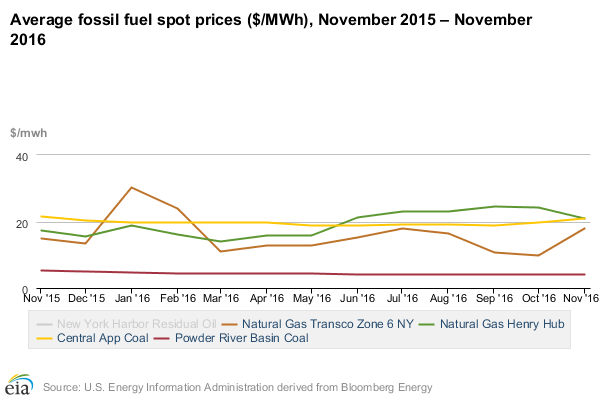
If you’re interested in the $/mmBtu, take a look at the chart below. Keep in mind that gas-fired combined cycle units tend to be more efficient than coal-fired steam units.
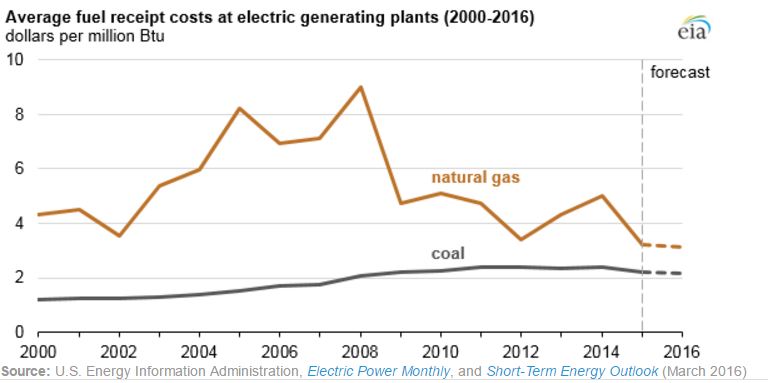
Due to the competitive pricing, natural gas consumption has been on the upswing since 1990 and now makes up 33% of the nation’s electricity generation (that’s one point higher than coal).
While renewable resources such as solar and wind are not yet major contributors of electricity generation, they have also seen consistent growth over the past several years, mainly due to reduced costs, making them more viable investments for states. According to Lazard, the unsubsidized levelized cost of solar PV has fallen 85% since 2009, and the cost of wind has fallen 66% for the same time period, bringing them line with and sometimes cheaper than coal. The chart below shows the levelized cost of all plant types for 2015; levelized cost is an economic assessment of the average total cost to build and operate a power-generating asset over its lifetime divided by the total energy output of the asset over that lifetime and is used to compare different methods of electricity generation on a consistent basis.
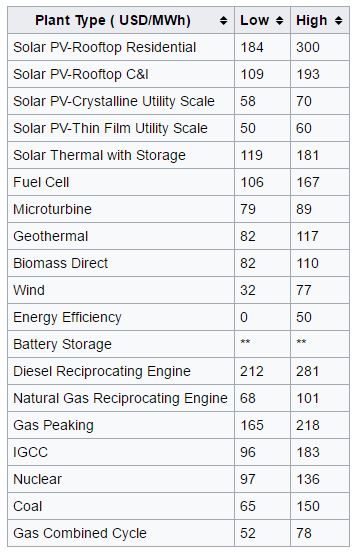
Levelized Cost of Energy by Fuel Source, 2015 (Lazard 2015)
Finally, in addition to lower demand at home, we are seeing lower need for coal exports. Typically, when demand has been low here, we could depend on other countries, such as China and India to help prop it up. However, due to environmental commitments of their own, from 2014-2015, China’s coal consumption declined an average 3.2% per year. And exports to India are not looking much better, as they have begun putting policies into place to reduce coal imports.
While shifts away from coal appear to be the key factor driving down the coal industry in today’s market, one can reasonably attribute those shifts to the increasing burdens the passage of stricter and stricter environmental laws have put on the industry, the awareness of pollution those laws have brought to the public’s attention, and the opportunity those laws have given other fuel sources to further develop and become competitive.
President Trump has committed himself to quite an undertaking when he says he is going to revive the coal industry. The downward trend has been a long time in the making, and it’s not likely he can affect the quick and drastic turnabout he’s vowed to put in motion with just the loosening of a few regulations.
